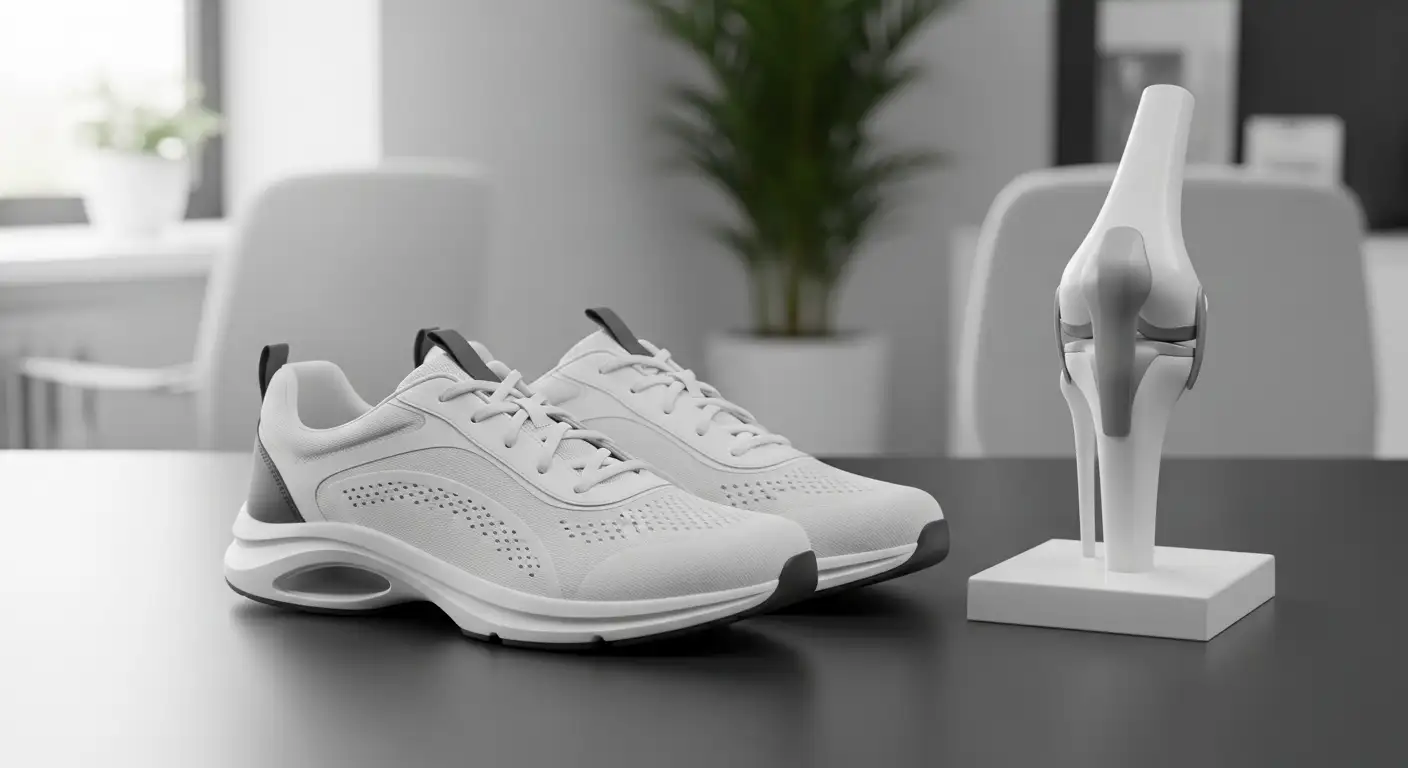Understanding Knee Bursitis and Its Impact
Knee bursitis is a common yet often misunderstood condition that causes pain, swelling, and limited mobility around the knee joint. It involves inflammation of the bursae—small fluid-filled sacs acting as cushions between bones, tendons, and muscles. Recognizing the causes, symptoms, and treatment options is crucial for effective management and swift recovery, whether you're an athlete, manual worker, or experiencing symptoms from daily activities.
Common Causes and Symptoms of Knee Bursitis
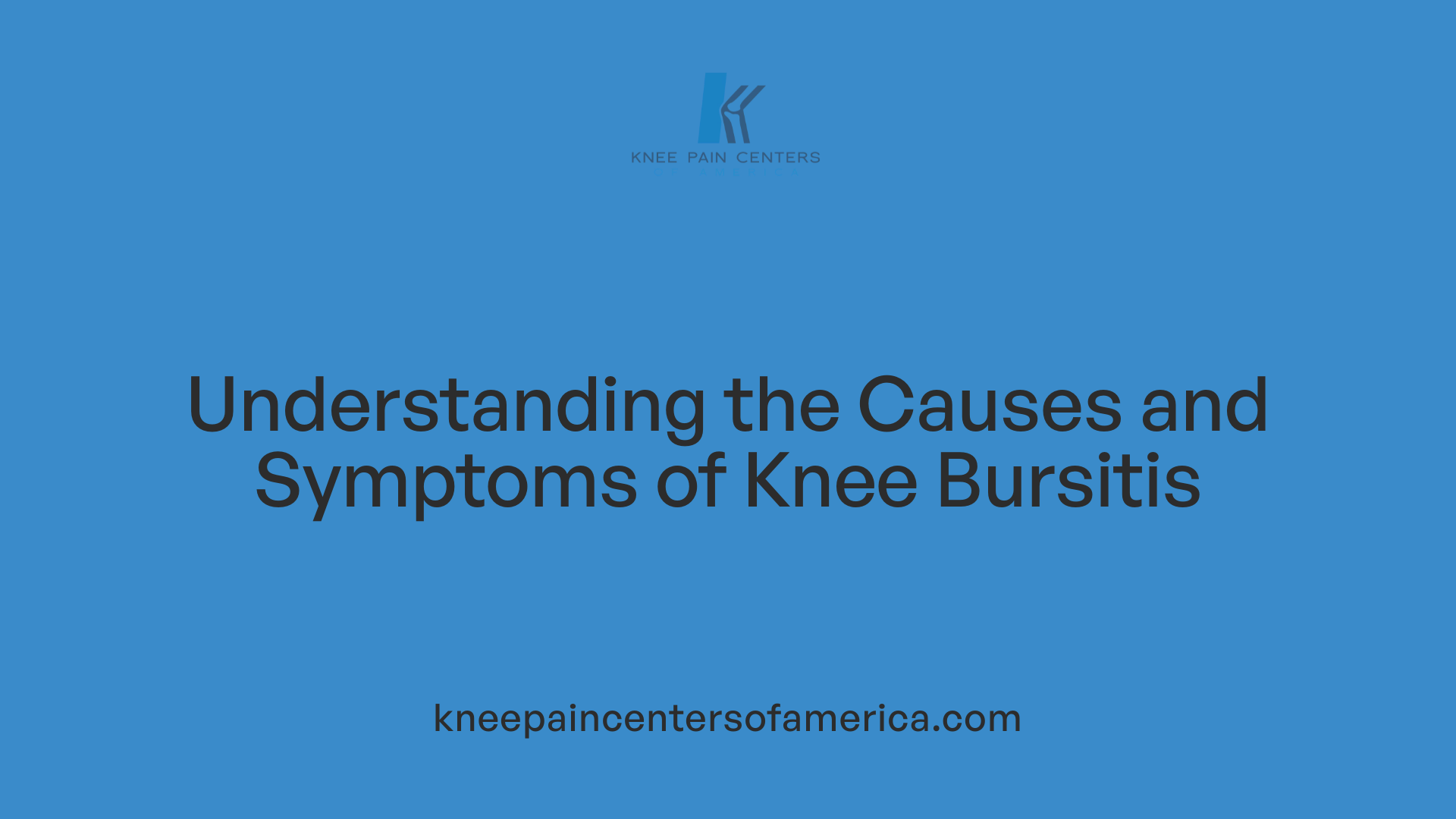 Knee bursitis is an inflammation of the bursae, small fluid-filled sacs that cushion the bones, tendons, and muscles around the knee joint to reduce friction and absorb pressure. This condition often results from repetitive or prolonged kneeling, direct trauma or injury, overuse from activities like jumping or running, bacterial infection through cuts or insect bites, or underlying health issues such as gout, rheumatoid arthritis, or osteoarthritis.
Knee bursitis is an inflammation of the bursae, small fluid-filled sacs that cushion the bones, tendons, and muscles around the knee joint to reduce friction and absorb pressure. This condition often results from repetitive or prolonged kneeling, direct trauma or injury, overuse from activities like jumping or running, bacterial infection through cuts or insect bites, or underlying health issues such as gout, rheumatoid arthritis, or osteoarthritis.
The symptoms of knee bursitis are generally localized and can vary depending on severity. Common signs include pain, tenderness, swelling, warmth, and redness over the affected area. These symptoms may be present during movement or at rest. In severe or infected cases, additional symptoms such as chills, fever, a general feeling of malaise, and skin discoloration may occur.
From a clinical perspective, diagnosis primarily involves a detailed physical examination and medical history assessment. The clinician looks for signs such as swelling, warmth, and tenderness, and evaluates the range of motion. Imaging techniques like ultrasound, MRI, or X-rays can be employed to visualize inflammation, rule out fractures, or detect other joint problems. If infection is suspected, a healthcare provider may perform aspiration—using a needle to remove fluid from the bursa for laboratory analysis—to test for bacteria, crystals, or blood, aiding in accurate diagnosis and guiding treatment.
Understanding the causes and recognizing the symptoms early are vital for effective management. A combination of rest, appropriate medical intervention, and preventive measures can help alleviate pain, prevent recurrence, and promote recovery.
Effective Self-Care and Conservative Management Approach
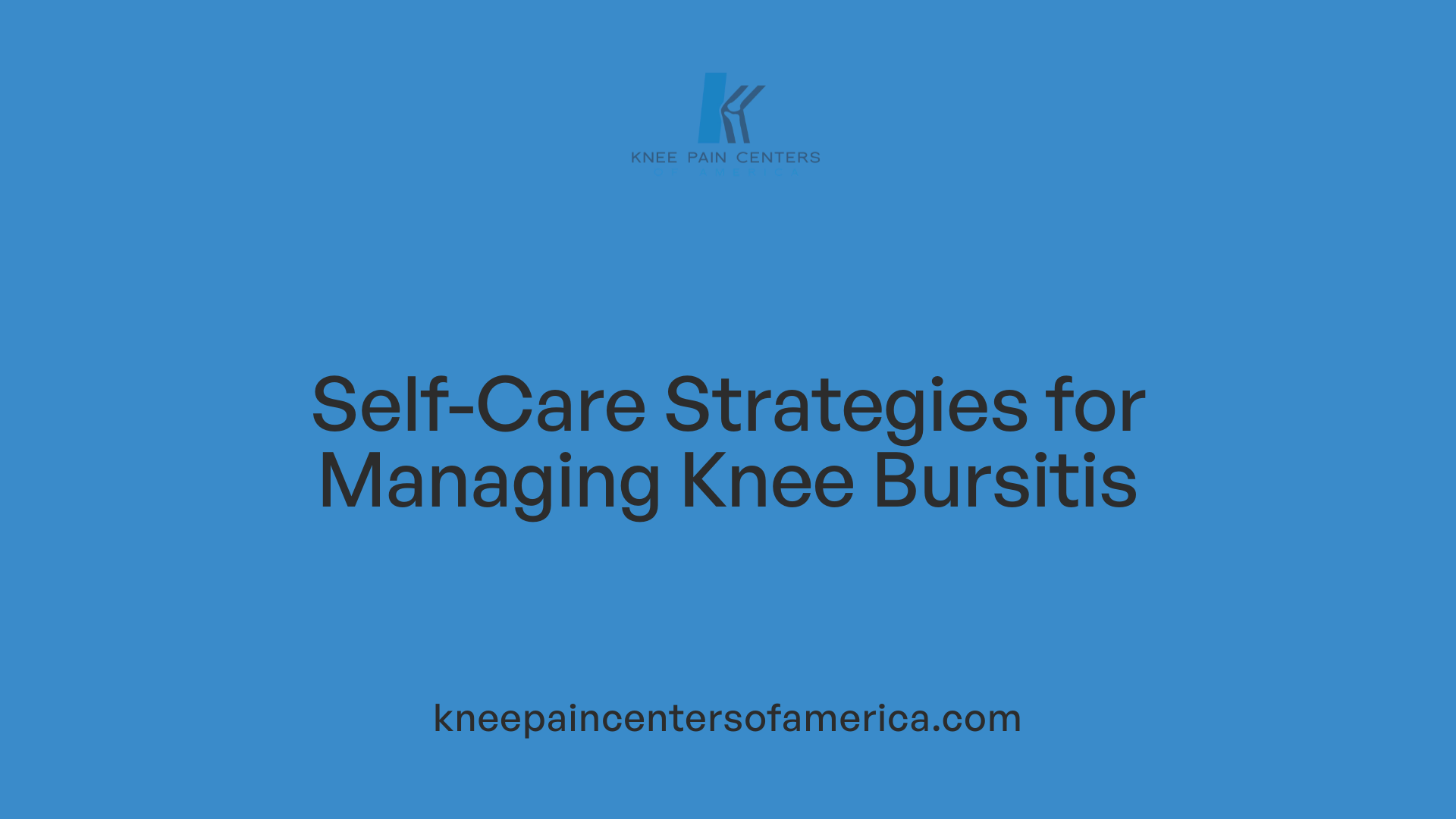
What self-care measures can help manage knee bursitis?
Managing knee bursitis effectively often starts with simple self-care steps that can significantly reduce symptoms and promote healing. Resting the affected knee is crucial; it helps to decrease inflammation and prevents further irritation of the bursae. Limiting activities that involve kneeling, jumping, or putting pressure on the knee gives the inflamed bursae a chance to recover.
Applying ice is an immediate and effective way to reduce swelling and pain. To do this, wrap an ice pack or cold compress in a cloth or towel to avoid direct contact with the skin, and apply it to the knee for about 15 minutes every few hours. This should be continued for the first 48 hours following injury or flare-up for the best results.
Elevating the leg while resting or sleeping can further help decrease swelling. Placing cushions or pillows under the knee or the lower leg ensures that the limb is above heart level, promoting fluid drainage and reducing inflammation.
Supporting the knee with compression bandages or sleeves is another beneficial measure. Compression helps to stabilize the joint, minimize swelling, and can provide a sense of stability while walking or moving. It should be snug but not too tight to avoid cutting off circulation.
In addition to these measures, over-the-counter pain relievers such as ibuprofen, naproxen, or acetaminophen can mitigate pain and control inflammation. These medications should be taken as directed, considering individual health conditions and allergies.
Most symptoms improve with these conservative measures within a few weeks. However, if pain or swelling persists beyond this period, worsens, or if there are severe signs like fever, redness, or inability to move the knee properly, consulting a healthcare professional is necessary. Sometimes, further interventions like aspiration of fluid or corticosteroid injections may be required.
In summary, consistent rest, ice application, elevation, compression, and appropriate use of pain medications form the foundation of self-care for knee bursitis, promoting faster recovery and preventing chronic issues.
Role of Medical and Surgical Interventions in Treatment
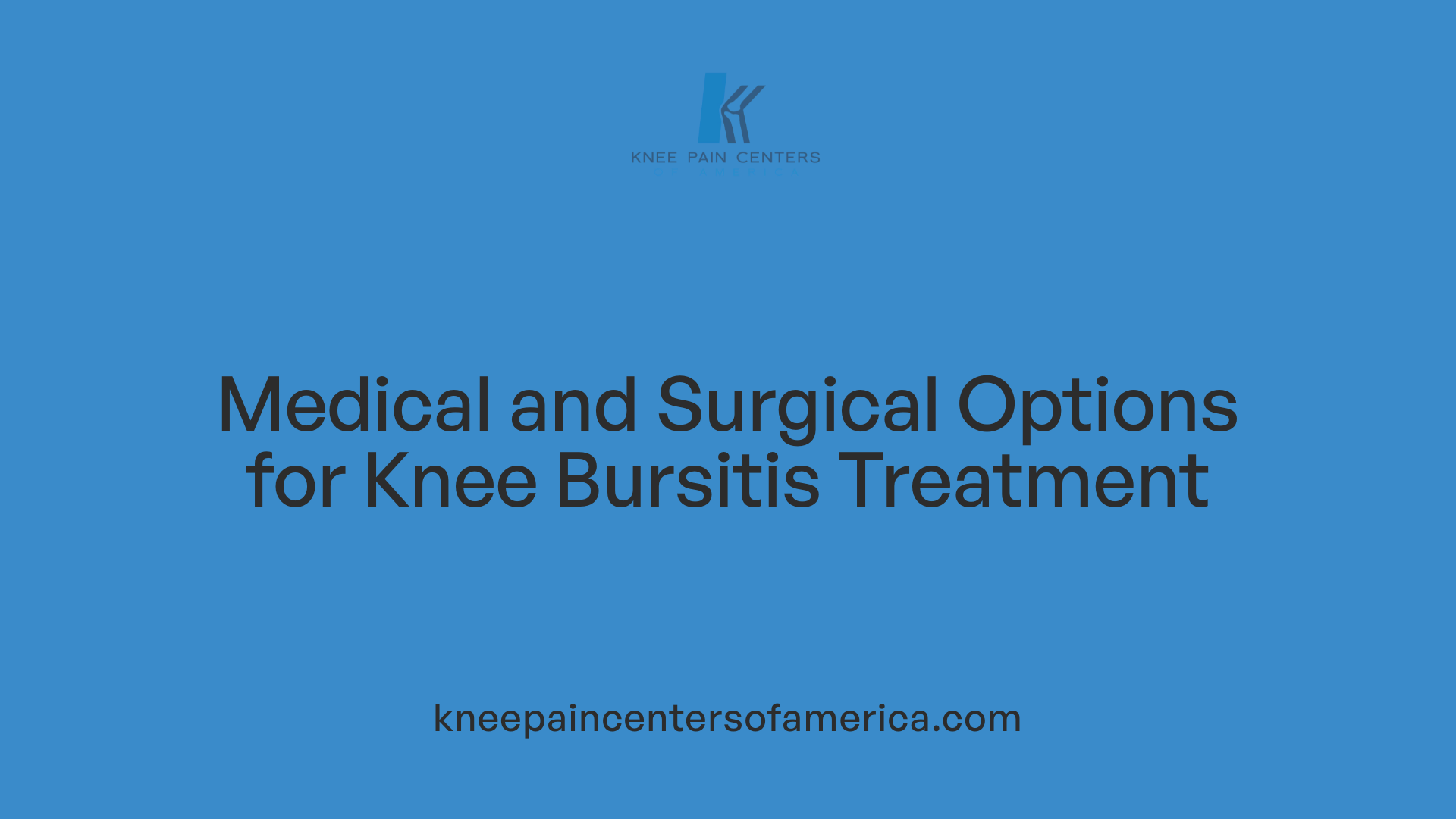
When are antibiotics needed for infected bursitis?
In cases where bursitis is caused by bacterial infection, antibiotics are essential to eliminate the infection and prevent complications. Septic bursitis typically presents with additional signs such as redness, warmth, fever, chills, and skin discoloration. Healthcare providers often perform an aspiration of the inflamed bursa to analyze the fluid for infection and identify the responsible bacteria. Once confirmed, appropriate antibiotics are prescribed based on the bacterial culture results. Timely antibiotic treatment can significantly reduce symptoms and avoid more invasive procedures.
Use of corticosteroid injections to quickly reduce inflammation
Corticosteroid injections play a vital role in managing bursitis when inflammation causes significant pain and swelling. These injections deliver potent anti-inflammatory medication directly into the inflamed bursa, providing rapid relief. They are especially helpful if over-the-counter medications and physical therapy do not fully alleviate symptoms. The goal is to decrease inflammation swiftly, restore joint mobility, and reduce dependence on oral medications. However, these injections should be administered by qualified healthcare professionals to minimize risks such as infection or tissue damage.
Procedures like aspiration of the inflamed bursa to remove excess fluid
Aspiration involves using a needle and syringe to drain excess fluid accumulated in the bursa. This procedure not only alleviates pressure and pain but also allows for analysis of the fluid to check for infection, gout, or other underlying conditions. Aspiration is a minimally invasive intervention that can provide immediate symptom relief. It is often performed under local anesthesia in a clinical setting. If the fluid analysis confirms infection, antibiotics are administered subsequently. Regular aspiration may be part of the treatment plan for recurrent bursitis cases.
Surgical options such as bursectomy for persistent, chronic bursitis unresponsive to conservative treatments
Surgical intervention, including bursectomy, involves the removal of the inflamed or infected bursa when bursitis persists beyond six months despite conservative measures like rest, medication, and aspiration. Surgery is also indicated in cases of severe infection, rupture, or if the bursitis significantly impairs function. The procedure is typically performed under anesthesia and may be open or minimally invasive, depending on the case. Postoperative physical therapy is crucial to regain strength and mobility. While surgery is effective in resolving chronic bursitis, it is generally considered a last resort after less invasive treatments have failed.
| Treatment Type | Purpose | When Used | Additional Notes |
|---|---|---|---|
| Antibiotics | Clear bacterial infection | Septic bursitis with signs of infection | Culture-guided selection is preferable |
| Corticosteroid injections | Rapid inflammation reduction | Severe inflammation unresponsive to NSAIDs | Administered under medical supervision |
| Aspiration | Remove excess fluid | Swelling and pain relief | Fluid analysis for infection or gout |
| Surgery (Bursectomy) | Remove inflamed bursa | Chronic or unresponsive bursitis | Post-surgical rehab vital for recovery |
Otherwise, most bursitis cases improve with conservative treatment. Proper diagnosis and timely intervention are significant for optimal recovery and prevention of complications.
Prevention Strategies and Long-term Care
How can bursitis be prevented or avoided from recurring?
To prevent bursitis from coming back, it is essential to minimize activities that put excessive pressure or cause irritation to the affected joints. Repetitive motions, prolonged kneeling, or heavy strain should be avoided or managed carefully. Incorporating warm-up and stretching routines before physical activities helps prepare the joints and muscles, reducing the risk of injury.
Using protective measures such as knee pads during kneeling activities can cushion the joint and prevent direct trauma. Proper techniques when lifting or moving heavy objects are also crucial in avoiding undue stress on the knee.
Maintaining a healthy weight reduces stress on the joints, especially important for weight-bearing areas like the knees. Excess weight increases pressure and can contribute to inflammation and bursitis.
Taking regular breaks during repetitive tasks or activities that involve joint stress allows tissues to recover and prevents chronic irritation.
Practicing good posture during work or physical activity supports joint health and prevents unnecessary strain. Physical therapy and exercises tailored to strengthen core and supporting muscles add stability to the joints and can lower the likelihood of inflammation.
What tips can help prevent knee bursitis?
Specific preventive tips for knee bursitis include wearing knee pads during activities that involve kneeling, such as gardening, construction, or sports. Taking frequent breaks allows the knee to rest and recover from repetitive motions.
Maintaining a healthy weight is particularly beneficial in reducing the load exerted on the knee joint, preventing inflammation and damage.
Warming up properly before exercise and engaging in gentle stretching routines help increase joint flexibility and prepare the muscles around the knee, reducing the risk of injury.
Strengthening the muscles surrounding the knee, including thigh muscles like the quadriceps and hamstrings, provides better support for the joint and decreases the likelihood of bursitis episodes.
Regular physical activity focusing on strength, flexibility, and endurance not only improves overall joint health but also helps prevent the reoccurrence of bursitis.
In summary, adopting protective strategies, maintaining healthy body mechanics, and strengthening supporting muscles are all vital components of long-term care for individuals susceptible to or recovering from bursitis.
| Prevention Strategies | Description | Additional Notes |
|---|---|---|
| Using knee pads | Wear protective padding during kneeling activities | Reduces direct trauma and pressure |
| Taking regular breaks | Rest periods during repetitive movements | Prevents overuse and inflammation |
| Maintaining a healthy weight | Keeps joint stress minimal | Decreases overall joint wear and tear |
| Warm-up and stretching | Prepares muscles and joints for activity | Enhances flexibility, prevents injury |
| Strengthening muscles around the knee | Exercises targeting thigh muscles | Supports joint stability and reduces strain |
Consulting healthcare professionals for personalized advice and ongoing management is recommended, especially for chronic or recurrent bursitis. Proper long-term care minimizes discomfort, prevents complications, and promotes joint longevity.
Search term for further information: "Knee bursitis prevention and long-term management".
Understanding the Role of Physical Therapy and Regenerative Treatments
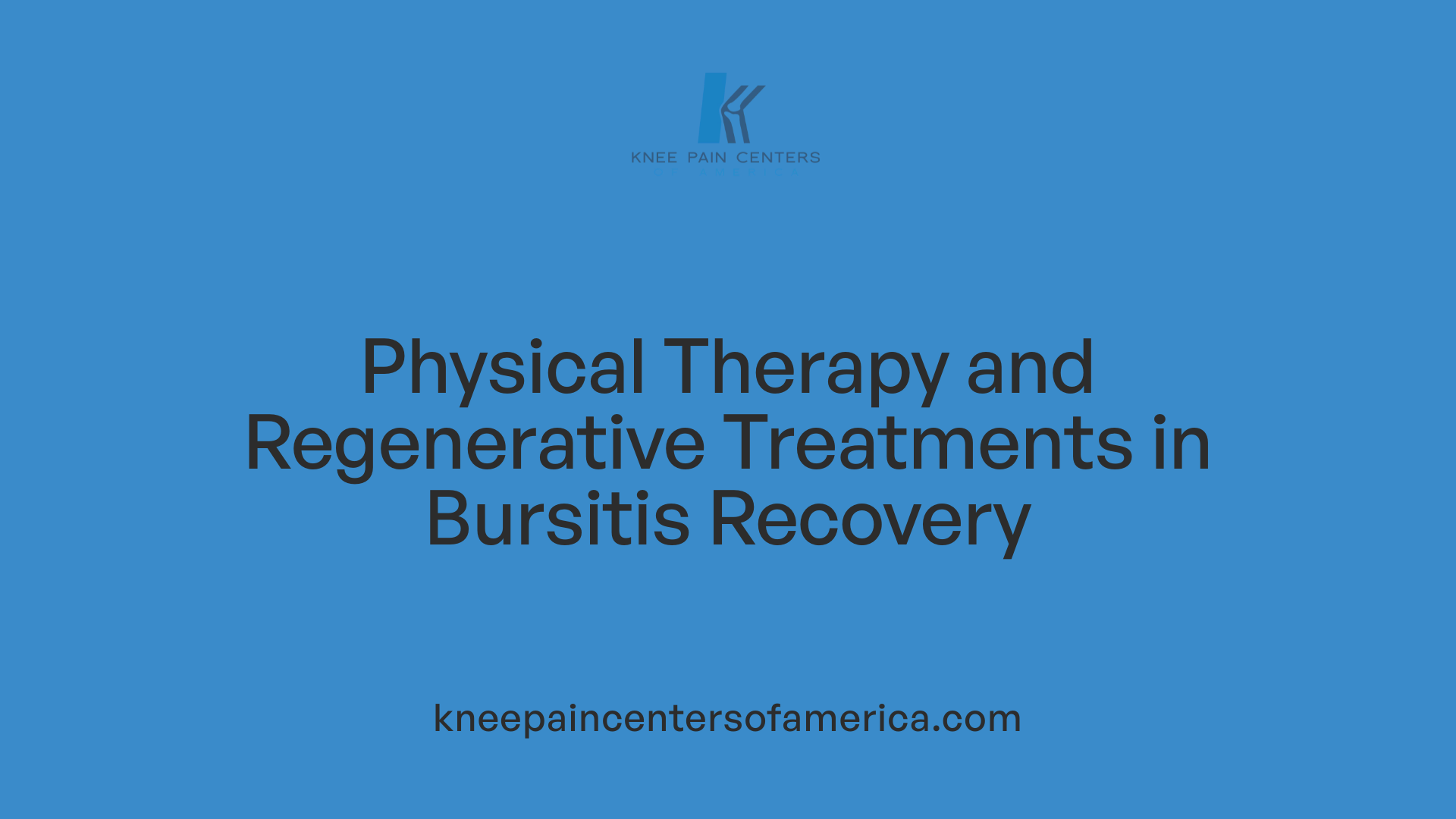
What physical therapy exercises support recovery from knee bursitis?
Physical therapy is a cornerstone in the treatment of bursitis, focusing on restoring function and preventing recurrence. Therapeutic exercises are tailored to each individual's condition, aiming to improve the range of motion, strengthen the muscles supporting the knee, and enhance flexibility.
Common exercises include gentle stretching of the hamstrings, quadriceps, and calf muscles, which helps reduce tension on the knee. Strengthening exercises such as leg raises, wall sits, and straight-leg lifts are designed to support the joint and improve stability.
Physical therapists often recommend low-impact activities like swimming or cycling, which minimize stress on the knee while maintaining mobility. Consistent movement and targeted exercises help prevent joint stiffness, reduce swelling, and expedite healing.
The importance of tailored programs designed by professionals
Not all cases of bursitis are the same, which makes personalized treatment plans essential. Physio professionals assess the severity of inflammation, joint stability, and muscle strength before designing specific exercises.
Tailored programs ensure that patients avoid movements that could aggravate the condition while emphasizing safe, effective exercises. This personalized approach accelerates recovery, minimizes pain, and decreases the risk of future episodes.
Emerging regenerative treatments such as PRP, stem cell therapy, and hydrodissection to promote healing
In recent years, regenerative medicine has gained traction as a promising option for treating persistent bursitis. Treatments like Platelet-Rich Plasma (PRP) involve concentrating the patient’s own blood platelets and injecting them into the affected area. This process promotes tissue repair, reduces inflammation, and stimulates healing.
Stem cell therapy uses concentrated stem cells to regenerate damaged tissues in or around the bursa. These treatments are minimally invasive and aim to repair the root cause of inflammation rather than just managing symptoms.
Hydrodissection is a technique where a fluid is injected to free adhesions and release trapped tissues, enhancing mobility and decreasing discomfort. This procedure can be combined with PRP or stem cell injections to optimize healing.
How these approaches can reduce reliance on medications or surgery
Regenerative treatments focus on stimulating natural healing mechanisms, which can decrease the need for prolonged medication use, such as anti-inflammatories or corticosteroids.
In many cases, these therapies can also delay or eliminate the need for surgical procedures like bursectomy. By promoting tissue repair from within, patients often experience faster recovery times, improved joint function, and fewer complications.
Using these advanced techniques as part of a comprehensive treatment plan allows for a more holistic and conservative approach, emphasizing long-term health and knee function.
| Treatment Method | Focus Area | Benefits | Suitable For |
|---|---|---|---|
| Physical Therapy | Exercises & Mobility | Restores movement, strengthens muscles | Mild to moderate bursitis |
| PRP & Stem Cell Therapy | Tissue regeneration | Reduces pain, promotes healing | Chronic or refractory bursitis |
| Hydrodissection | Soft tissue release | Improves mobility, reduces adhesions | Adhesion-related or persistent cases |
These innovative treatments exemplify a shift towards biological solutions that aim to restore natural tissue health and joint function, ultimately offering patients more options for effective, less invasive care.
Summary and Long-Term Management
Knee bursitis can significantly impact daily activities, but with proper understanding and management strategies, relief is achievable. The key lies in early diagnosis, implementing conservative treatments such as rest, ice, compression, and NSAIDs, and adopting preventive practices like using protective gear and maintaining a healthy weight. When symptoms persist or worsen, medical interventions, including aspiration, corticosteroid injections, or surgery, may be necessary. Moreover, integrating physical therapy and emerging regenerative treatments can enhance recovery and prevent recurrence. By being proactive and educated about the condition, individuals can effectively manage knee bursitis, restore mobility, and prevent future episodes, ensuring a healthier, pain-free life.
References
- Prepatellar Bursitis (Knee Bursitis): Symptoms & Treatment
- Bursitis - NHS
- How to Treat Knee Bursitis Pain and Swelling - WebMD
- Bursitis: Types, Treatment & Prevention - Cleveland Clinic
- Knee bursitis | UM Health-Sparrow
- Knee bursitis - Symptoms and causes - Mayo Clinic
- Knee Bursitis: Causes, Symptoms, and Treatment Options
- 6 Tips to Treat Bursitis in the Knee - The Bone & Joint Center
- Knee Bursitis: Treatment, Causes, Symptoms, and Prevention
- 9 Self-Care Tips for Acute or Chronic Bursitis

